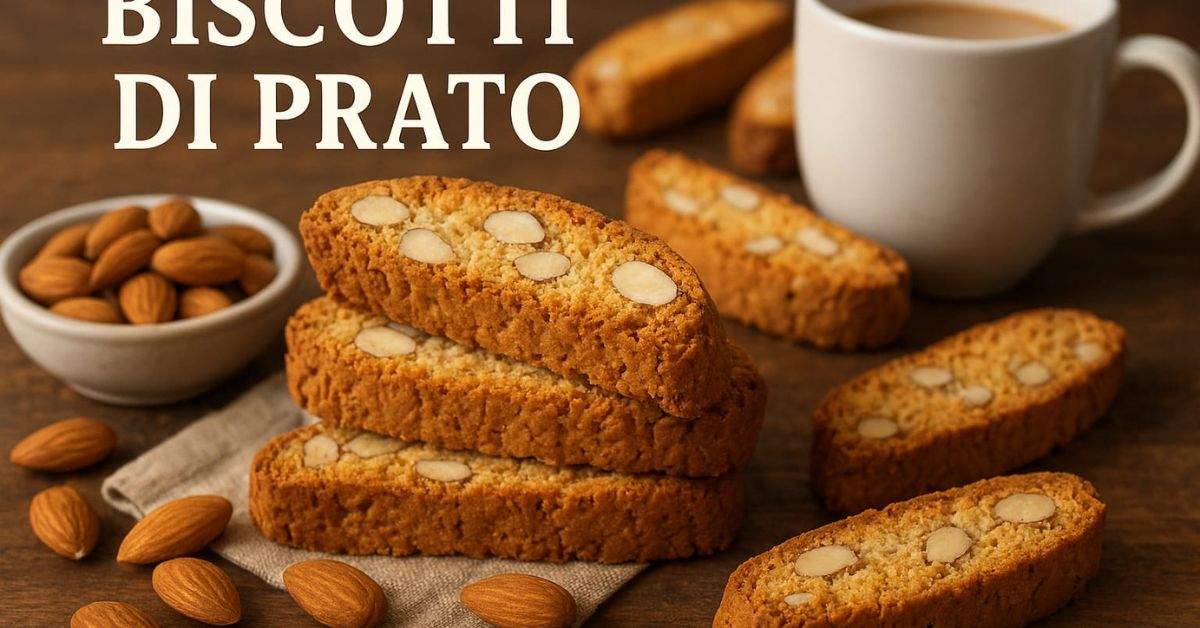Introduction
Few baked treats can claim the cultural weight and culinary heritage of Бишкоти ди Прато, a biscuit that has endured for centuries as a symbol of Italian craftsmanship. Often associated with the charming town of Prato in Tuscany, this crisp, twice-baked almond cookie has traveled far beyond the cobbled streets of its origins, earning a place in gourmet kitchens and humble households alike.
In 2025, with renewed interest in authentic, artisanal baking, Бишкоти ди Прато has made a striking comeback. The aroma of toasted almonds, the firm crunch softened by dipping in sweet wine, and the elegant simplicity of its preparation continue to captivate bakers and foodies around the globe. This article delves deep into everything you need to know: its origin story, recipe tips, variations, cultural significance, and how you can make the most of it today.
Whether you’re a home baker wanting to master a traditional Italian recipe or a culinary explorer curating authentic flavors, keep reading—this guide is for you.
A Brief History of Бишкоти ди Прато

Originating in the Tuscan city of Prato, this almond biscuit finds its roots in the Middle Ages. The name Бишкоти ди Прато refers specifically to the version made famous in this region, though similar biscuits exist across Italy under different names like cantucci or cantuccini.
Key Moments in Its History
- Medieval Roots: Originally baked by monks for sustenance, thanks to its long shelf life.
- Renaissance Era: Gained popularity in Florentine society.
- 19th Century: Became a staple of Tuscan cuisine, particularly alongside Vin Santo (a sweet dessert wine).
Fun Fact: The term “biscotti” comes from Latin bis (twice) and coctum (cooked), literally meaning “twice-baked”—a key technique that gives this treat its signature crunch.
Explore the history of Бишкоти ди Прато and discover how AI Tools are transforming traditional baking methods today.
Ingredients that Make it Unique
The magic behind this Italian biscuit lies in its simplicity. Traditional recipes limit themselves to just a few ingredients—most of which are likely already in your pantry.
Basic Traditional Ingredients
| Ingredient | Purpose in Recipe |
| Almonds | Adds crunch and nutty aroma |
| Flour | Base for structure |
| Sugar | Sweetens and contributes to browning |
| Eggs | Binds the dough, adds moisture |
| Baking Powder | Optional in modern versions |
Note: Authentic Бишкоти ди Прато contains no butter or oil, giving it a drier texture that pairs perfectly with wine.
How It’s Made: Step-by-Step Process
Making Бишкоти ди Прато at home is not as intimidating as it may seem. Despite its elegant final form, the recipe is relatively straightforward for bakers of all levels.
Step-by-Step Overview
- Prepare the Dough: Mix flour, sugar, baking powder, and eggs until a sticky dough forms.
- Fold in Almonds: Traditionally left whole, skins on.
- Shape into Logs: Divide dough, roll into logs about 2 inches wide.
- First Bake: 25 minutes at 175°C (347°F), logs should become lightly golden.
- Slice & Second Bake: After cooling for 10 minutes, slice diagonally and bake again for 10–15 minutes.
What’s the Difference Between Biscotti and Бишкоти ди Прато?
This is where many get confused. While all Бишкоти ди Прато are biscotti, not all biscotti qualify as the original Prato biscuit.
Side-by-Side Comparison
| Feature | Biscotti (Generic) | Бишкоти ди Прато |
| Origin | Various, often commercial | Prato, Tuscany |
| Nuts Used | Any (pistachio, hazelnut) | Usually almonds |
| Fat Content | May include butter/oils | Traditional: no added fat |
| Texture | Can vary (soft to crunchy) | Always exceptionally crunchy |
| Pairing | Coffee, tea | Traditionally with Vin Santo |
Understanding this distinction not only enhances appreciation but also helps in selecting authentic products or recipes.
The Cultural Significance in Tuscany
Бишкоти ди Прато is more than just a biscuit in Tuscany—it’s a symbol of heritage, family, and festivity.
Key Cultural Roles
- Festive Celebrations: Present at weddings, birthdays, and Christmas dinners.
- Gifts and Souvenirs: Often sold in artisanal bakeries in decorative tins.
- Culinary Tourism: Guiding tours in Tuscany often include baking classes for this particular treat.
In 2025, Prato city began hosting an annual “Biscotti Week” featuring competitions, tasting events, and workshops that draw in thousands.
Modern Twists and Variations
While purists prefer the classic version, today’s bakers are experimenting with new flavors and formats.
Popular Variations in 2025
- Chocolate-Dipped Ends: Adds a modern dessert-like feel.
- Citrus Zest Infusions: Lemon, orange, or bergamot.
- Savory Options: Parmesan and rosemary for aperitivo menus.
- Vegan Variants: Using aquafaba instead of eggs.
These innovations respect tradition while making Бишкоти ди Прато more accessible to modern palates.
Buying Guide: How to Choose Authentic Бишкоти ди Прато
Supermarket shelves and online retailers are flooded with biscotti labeled as “authentic.” So what distinguishes real Бишкоти ди Прато?
Look For
- Origin Labeling: “Made in Prato” or “IGP Toscana” tags.
- Ingredients: No butter or oils should be listed.
- Texture: Should be rock-firm, ideally requiring sipping with wine or coffee.
Authentic brands to consider in 2025 include: Mattei Biscottificio (Prato), Dolcezze di Toscana, and Sapori Antichi.
Pairings: More Than Just a Biscuit
Traditionally enjoyed with Vin Santo, this treat now finds its way into modern pairings.
Prime Pairings
- Wine: Vin Santo, Moscato, Recioto.
- Coffee: Espresso, cappuccino.
- Cheese Plates: Aged pecorino, gorgonzola Dolce.
- Gelato: Crumbled over vanilla or almond flavors.
In 2025, chefs in Rome and Milan are curating dessert boards where this biscuit is the centerpiece.
Shelf Life and Storage Tips
One of the biscuit’s biggest perks is its extended freshness.
Storage Secrets
- Airtight Container: Keeps them crisp for 3–4 weeks.
- Don’t Refrigerate: Moisture ruins the texture.
- Freeze-Friendly: Can freeze uncooked logs and bake later.
Based on a 2025 food preservation report by La Cucina Moderna, properly stored versions retained quality up to 60 days.
How to Make Бишкоти ди Прато a Part of Your Daily Ritual
Adopting Italian food traditions is about more than eating—it’s about living.
Easy Ideas
- Begin your morning with a biscuit and espresso.
- Use crumbled biscuits as a base for cheesecakes.
- Gift in jars tied with local linen wraps.
In today’s slow food movement, this timeless treat encourages mindfulness and connection—making everyday moments feel a little more Italian.
Data Visualization: Biscotti Market Trends 2015–2025
| Year | Global Biscotti Market ($B) | % Growth YoY |
| 2015 | 1.2 | — |
| 2020 | 1.9 | +7.2% |
| 2025 | 2.8 (projected) | +8.5% |
Source: Food Industry Report 2025, Statista
Frequently asked questions (FAqs)
What makes Бишкоти ди Прато different from other biscotti?
Its origin in Prato, whole almond filling, and absence of butter distinguish it from commercial variants.
Can I make it vegan?
Yes, substitute eggs with aquafaba or flaxseed “eggs”.
Is it gluten-free?
The traditional recipe contains wheat; however, gluten-free flours work well for adaptations.
How should I store it?
In an airtight container at room temperature for up to four weeks.
Is it safe for kids?
Absolutely—it’s a wholesome snack, just note the hard texture.
Conclusion
In every bite of Бишкоти ди Прато, history, tradition, and comfort come together. Its staying power lies in its simplicity and the ritual it invites—dipping into wine, sharing with friends, or savoring with coffee. Whether you bake it yourself or buy from a trusted source, you’re not just enjoying a biscuit—you’re experiencing a slice of Tuscan heritage.
